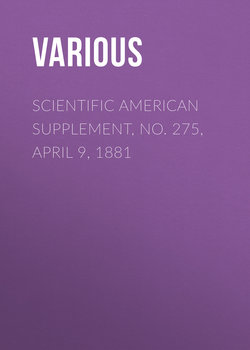Читать книгу Scientific American Supplement, No. 275, April 9, 1881 - Various - Страница 1
WHEAT AND WHEAT BREAD
ОглавлениеBy H. MÈGE-MOURIÈS
In consequence of the interest that has been recently excited on the subject of bread reform, we have, says the London Miller, translated the interesting contribution of H. Mège-Mouriès to the Imperial and Central Society of Agriculture of France, and subsequently published in a separate form in 1860, on "Wheat and Wheat Bread," with the illustration prepared by the author for the contribution. The author says: "I repeat in this pamphlet the principal facts put forth in the notes issued by me, and in the reports furnished by Mr. Chevreul to the Academy of Science, from 1853 up to 1860."
The study of the structure of the wheat berry, its chemical composition, its alimentary value, its preservation, etc., is not alone of interest to science, agriculture, and industry, but it is worthy of attracting the attention of governments, for this study, in its connection to political economy, is bound up with the fate and the prosperity of nations. Wheat has been cultivated from time immemorial. At first it was roughly crushed and consumed in the form of a thick soup, or in cakes baked on an ordinary hearth. Many centuries before the Christian era the Egyptians were acquainted with the means of making fermented or leavened bread; afterwards this practice spread into Greece, and it is found in esteem at Rome two centuries B.C.; from Rome the new method was introduced among the Gauls, and it is found to-day to exist almost the same as it was practiced at that period, with the exception, of course, of the considerable improvements introduced in the baking and grinding.
Since the fortunate idea was formed of transforming the wheat into bread, this grain has always produced white bread, and dark or brown bread, from which the conclusion was drawn that it must necessarily make white bread and brown bread; on the other hand, the flours, mixed with bran, made a brownish, doughy, and badly risen bread, and it was therefore concluded that the bran, by its color, produced this inferior bread. From this error, accepted as a truth, the most contradictory opinions of the most opposite processes have arisen, which are repeated at the present day in the art of separating as completely as possible all the tissues of the wheat, and of extracting from the grain only 70 per cent of flour fit for making white bread. It is, however, difficult for the observer to admit that a small quantity of the thin yellow envelope can, by a simple mingling with the crumb of the loaf, color it brown, and it is still more difficult to admit that the actual presence of these envelopes can without decomposition render bread doughy, badly raised, sticky, and incapable of swelling in water. On the other hand, although some distinguished chemists deny or exalt the nutritive properties of bran, agriculturists, taking practical observation as proof, attribute to that portion of the grain a physiological action which has nothing in common with plastic alimentation, and prove that animals weakened by a too long usage of dry fodder, are restored to health by the use of bran, which only seems to act by its presence, since the greater portion of it, as already demonstrated by Mr. Poggiale, is passed through with the excrement.
With these opinions, apparently so opposed, it evidently results that there is an unknown factor at the bottom of the question; it is the nature of this factor I wish to find out, and it was after the discovery that I was able to explain the nature of brown bread, and its role in the alimentation of animals. We have then to examine the causes of the production of brown bread, to state why white bread kills animals fed exclusively on it, while bread mixed with bran makes them live. We have to explain the phenomena of panification, the operations of grinding, and to explain the means of preparing a bread more economical and more favorable to health. To explain this question clearly and briefly we must first be acquainted with the various substances forming the berry, their nature, their position, and their properties. This we shall do with the aid of the illustration given.
SECTION OF A GRAIN OF WHEAT MAGNIFIED.
EXPLANATION OF DIAGRAM.
